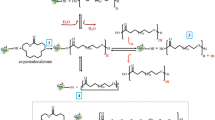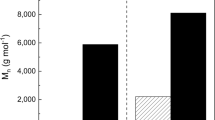Abstract
Candida is a genus of yeast, and lipase B isolated from Candida antarctica (CALB) has been utilized as a biocatalyst for the synthesis of a variety of organic compounds including polyesters and polylactones. Among the various immobilization media reported in the literature, the porous acrylic resin utilized in Novozym-435 has been widely studied. Here, we report the enzyme recovery and reuse for the synthesis of poly(ε-caprolactone) in toluene at 70 °C for 4 h per cycle for up to 10 reaction cycles, which consistently resulted in polymers with a weight-average molecular weight, M w , of ~50,000 g mol−1 and a polydispersity index of ~1.4. In addition, the thermal properties of the resin particles used in Novozym-435, with and without the enzyme, were evaluated by TGA and DSC analysis. The effect of mechanical agitation on the enzyme stability, recovery, and reuse was also discussed. These results may have significance to enzymatic polymer synthesis as well as to the enzyme immobilization on acrylic resins and other matrices.







Similar content being viewed by others
References
Brady L, Brzozowski AM, Derewenda ZS, Dodson E, Dodson G, Tolley S, Turkenburg JP, Christiansen L, Huge-Jensen B, Norskov L, Thim L, Menge U (1990) A serine protease triad forms the catalytic centre of a triacylglycerol lipase. Nature 43:767–770
Mateo C, Palomo JM, Fernandez-Lorente G, Guisán JM, Fernandez-Lafuente R (2007) Improvement of enzyme activity, stability and selectivity via immobilization techniques. Enzyme Microb Technol 40:1451–1463
Salis A, Meloni D, Ligas S, Casula MF, Monduzzi M, Solinas V, Dumitriu E (2005) Physical and chemical adsorption of Mucor javanicus lipase on SBA-15 mesoporous silica. Synthesis, structural characterization, and activity performance. Langmuir 21:5511–5516
David AE, Wang NS, Yang VC, Yang AJ (2006) Chemically surface modified gel (CSMG): an excellent enzyme-immobilization matrix for industrial processes. J Biotechnol 125:395–407
Knezevic Z, Milosavic N, Bezbradica D, Jakovljevic Z, Prodanovic R (2006) Immobilization of lipase from Candida rugosa on Eupergit® C supports by covalent attachment. Biochem Eng J 30:269–278
Ragheb AM, Brook MA, Hrynyk M (2005) Highly active, lipase silicone elastomers. Biomaterials 26:1653–1664
Chen B, Hu J, Miller EM, Xie W, Cai M, Gross RA (2008) Candida antarctica lipase B chemically immobilized on epoxy-activated micro- and nanobeads: catalysts for polyester synthesis. Biomacromolecules 9:463–471
Luckarift HR, Spain JC, Naik RR, Stone MO (2004) Enzyme immobilization in a biomimetic silica support. Nat Biotechnol 22:211–213
Reetz MT, Zonta A, Simpelkamp J (1996) Efficient immobilization of lipases by entrapment in hydrophobic sol–gel materials. Biotechnol Bioeng 49:527–534
Bishwabhusan S, Brandstadt KF, Lane TH, Gross RA (2005) “Sweet silicones”: biocatalytic reactions to form organosilicon carbohydrate macromers. Org Lett 18:3857–3860
Moris F, Gotor V (1993) A useful and versatile procedure for the acylation of nucleosides through an enzymic reaction. J Org Chem 58:653–660
Bertinotti A, Carrea G, Ottolina G, Riva S (1994) Regioselective esterification of polyhydroxylated steroids by Candida antarctica lipase B. Tetrahedron 50:13165–13172
Hansen TV, Waagen V, Partli V, Anthosen HW, Anthosen T (1995) Co-solvent enhancement of enantioselectivity in lipase-catalysed hydrolysis of racemic esters. A process for production of homochiral C-3 building blocks using lipase B from Candida antarctica. Tetrahedron Asymmetry 6:499–504
Frykman H, Ohmer N, Norin T, Hult K (1993) S-ethyl thiooctanoate as acyl donor in lipase catalysed resolution of secondary alcohols. Tetrahedron Lett 34:1367–1370
Arroyo M, Sinisterra J (1994) High enantioselective esterification of 2-arylpropionic acids catalyzed by immobilized lipase from Candida antarctica: a mechanistic approach. J Org Chem 59:4410–4417
Gross RA, Kumar A, Kalra B (2001) Polymer synthesis by in vitro enzyme catalysis. Chem Rev 101:2097–2124
Poojari Y, Palsule AS, Cai M, Clarson SJ, Gross RA (2008) Synthesis of organosiloxane copolymers using enzymatic polyesterification. Eur Polym J 44:4139–4145
Poojari Y, Clarson SJ (2009) Lipase catalyzed synthesis of poly(ε-caprolactone)–poly(dimethylsiloxane)–poly(ε-caprolactone) triblock copolymers. Silicon 1:165–172
Poojari Y, Clarson SJ (2009) Lipase catalyzed synthesis of silicone polyesters. Chem Comm 6834–6835
Poojari Y, Clarson SJ (2010) Lipase catalyzed synthesis and thermal properties of poly(dimethylsiloxane)–poly(ethylene glycol) amphiphilic block copolymers. J Inorg Organomet Polym 20:46–52
Mei Y, Miller L, Gao W, Gross RA (2003) Imaging the distribution and secondary structure of immobilized enzymes using infrared microspectroscopy. Biomacromolecules 4:70–74
Zaks A, Klibnov AM (1985) Enzyme-catalyzed processes in organic solvents. Proc Natl Acad Sci 82:3192–3196
Wong C-H (1989) Enzymatic catalysts in organic synthesis. Science 244:1145–1152
Kumar A, Gross RA (2000) Candida antartica lipase B catalyzed polycaprolactone synthesis: effects of organic media and temperature. Biomacromolecules 1:133–138
Namekawa S, Suda S, Uyama H, Kobayashi S (1999) Lipase-catalyzed ring-opening polymerization of lactones to polyesters and its mechanistic aspects. Int J Biol Macromol 25:145–151
Kobayashi S, Uyama H, Namekawa S (1995) Enzymatic ring-opening polymerization of lactones to polyesters by lipase catalyst: unusually high reactivity of macrolides. Bull Chem Soc Jpn 68:56–61
Wiemann LO, Nieguth R, Eckstein M, Naumann M, Thum O, Ansorge-Schumacher MB (2009) Composite particles of novozyme 435 and silicone: advancing technical applicability of macroporous enzyme carriers. ChemCatChem 1:455–462
Acknowledgments
We thank the National Science Foundation for Center Funding to UC (Clarson) under an NSF TIE Grant, NSF #0631412. We thank Professor Richard A. Gross (POLY, Brooklyn, NY) for helpful discussions and for friendly collaborations with his research group.
Author information
Authors and Affiliations
Corresponding author
Rights and permissions
About this article
Cite this article
Poojari, Y., Beemat, J.S. & Clarson, S.J. Enzymatic synthesis of poly(ε-caprolactone): thermal properties, recovery, and reuse of lipase B from Candida antarctica immobilized on macroporous acrylic resin particles. Polym. Bull. 70, 1543–1552 (2013). https://doi.org/10.1007/s00289-013-0916-1
Received:
Revised:
Accepted:
Published:
Issue Date:
DOI: https://doi.org/10.1007/s00289-013-0916-1




